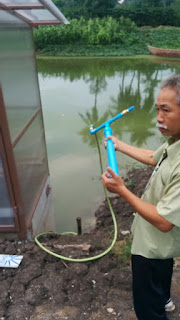The 220V AC air pump we bought for about $60 a while back from an aquarium supply shop was horribly inefficient.
From basic physics, power is equal to force times speed. For an air pump pumping air into water, you can calculate the force as the difference between air pressure at the pump, and water pressure at the depth that you are trying to pump the air into. This would determine the backwards force on the air pump. The rate at which the air is pushed out of the pump determines the speed.
Using only the numbers listed on the box, it appears that the pump we purchased is using 200W of electricity to give us about 5W of pumping action. This is only about 2.5% efficiency. Pretty horrible.
As most of you have already noticed, when the commercial options seem pretty bad, my next instinct is to build a prototype to see how hard it is to do better. Here it is:
This is a hand air pump built mostly from PVC pipe. Inside is a 3D printed PLA piston attached to the aluminum extrusion shaft coming out the left side. O-rings around the PLA piston provide quite a good seal between it and the PVC pipe. On the right side, you can see two brass colored pieces that are cheap one way valves designed for water pipes. This provides a mechanism to suck air in from the inlet (bottom one) when the piston is pulled back and push it out the outlet (top one) when the piston is pushed in. The outlet is attached to a green high pressure tubing that runs into the pond and is attached to a large aeration stone that is placed on the edge of the pond a few meters down. (The stone looks something like this.)
Here is another picture of it in action:
WARNING: It must be noted that it is dangerous to use PVC pipe for high pressure compressed air applications. Here is a page on the subject. There is a note at the bottom that you should leave “large factors of safety” due to PVC’s tendency to explode unsafely if it ruptures while holding a compressed gas. The pressure we need is about 0.3 bar, while the PVC is rated at 5 bar. This appears to be a very large safety margin. Nonetheless I will likely look into other options when I build the actual pump. Part of this is due to the fact that PVC weakens quickly at higher temperatures, and compressed gases can rise to high temperatures. While the pressures we are talking about are a small fraction of what most people refer to as “compressed air”, it still isn’t worth taking chances. DO NOT TRY THIS AT HOME. You have been warned.
Back to the test…
So the pump worked quite well in this prototype form, and with very little manual effort it was able to pump a substantial amount of air down into the pond. Here is a photo of the bubbles coming up:
For reference, this ring of bubbles was about half a meter in diameter.
For an actual pump, we would need to add a crankshaft and a motor. For the motor, I am looking into using a windshield wiper motor if I can source one at a reasonable price.
I did observe a significant inefficiency that the piston springs back about 18 cm after pushing it in all the way:
This would result in a moderate loss since the motor will have to do the work of pushing the piston all the way in, even though not all of the air is being pushed out to the water. I reason that this can be improved greatly by reducing the amount of air left between the end of the piston when it is fully depressed and the one-way valves that handle air-flow. If this “chamber” of left-over air is made small, then more of the air will be pushed out into the pond for the same amount of mechanical work done by the pump.
More on this air pump to come.


